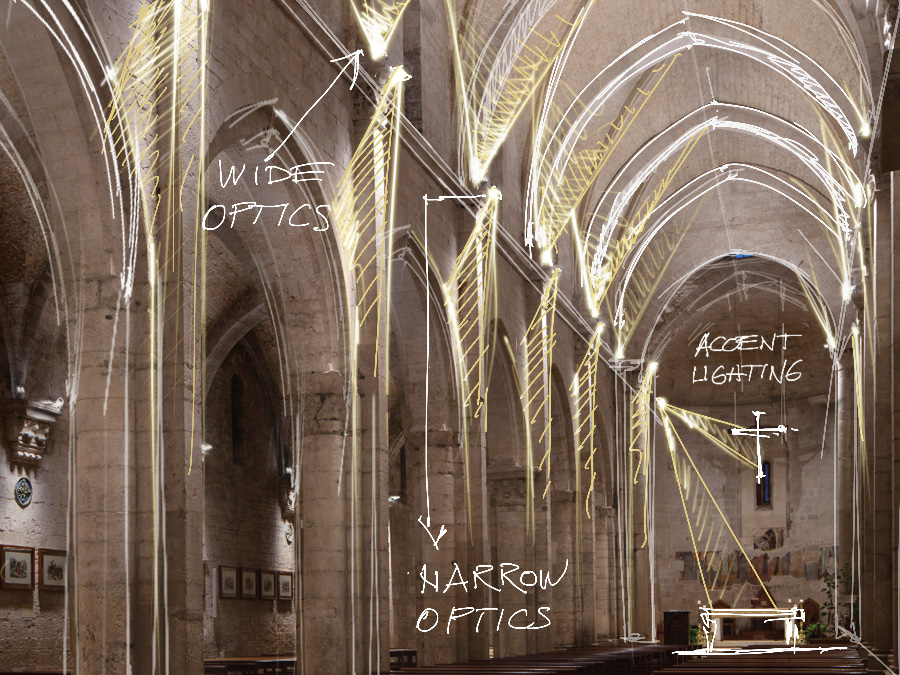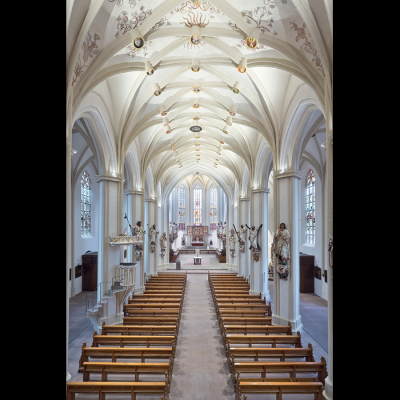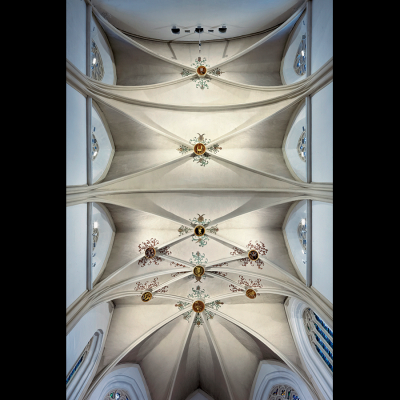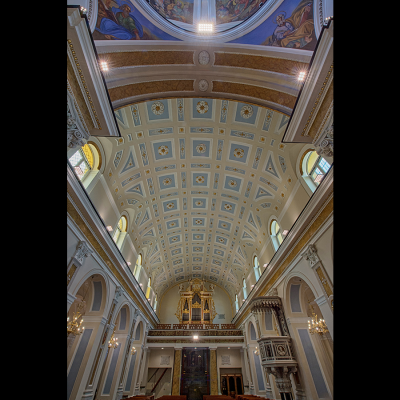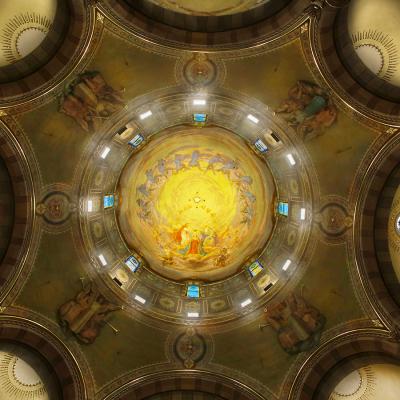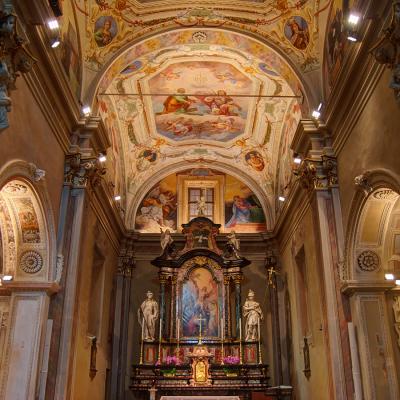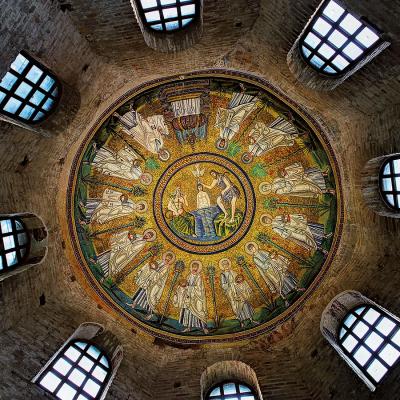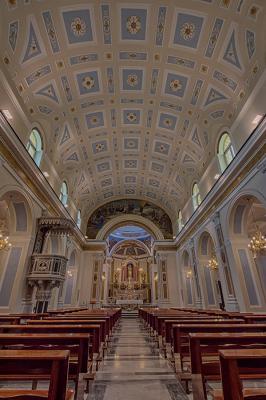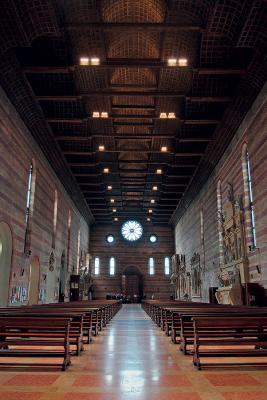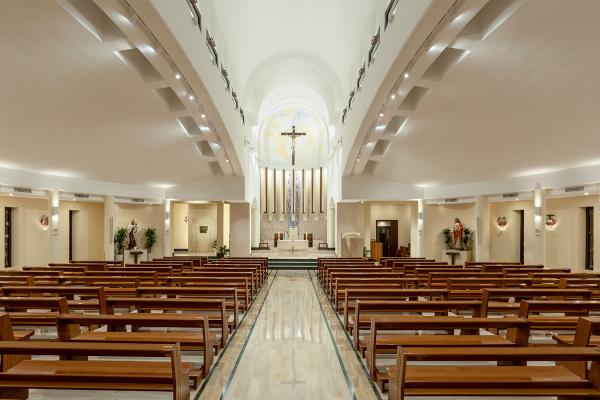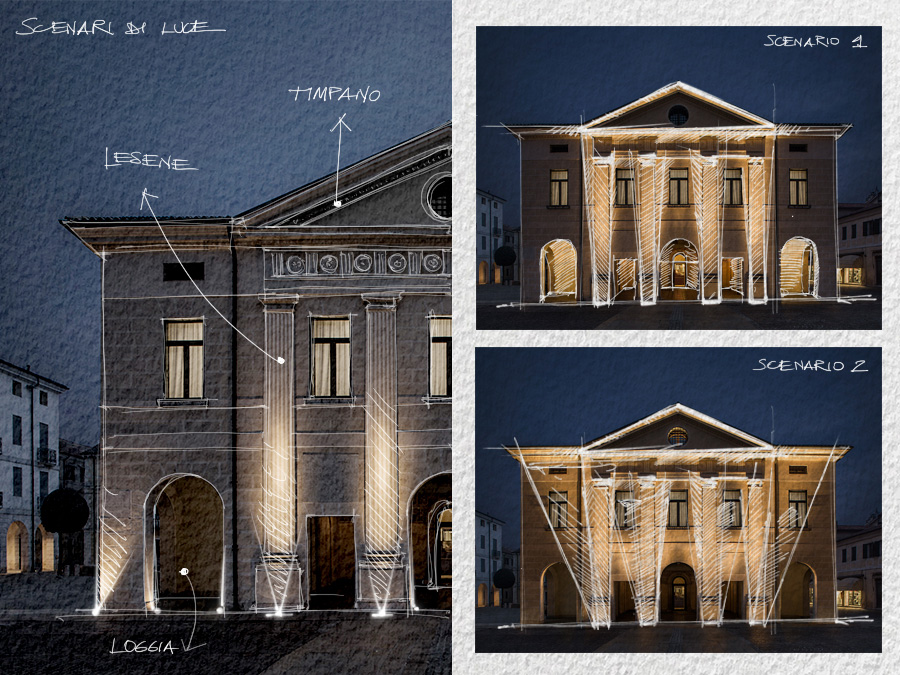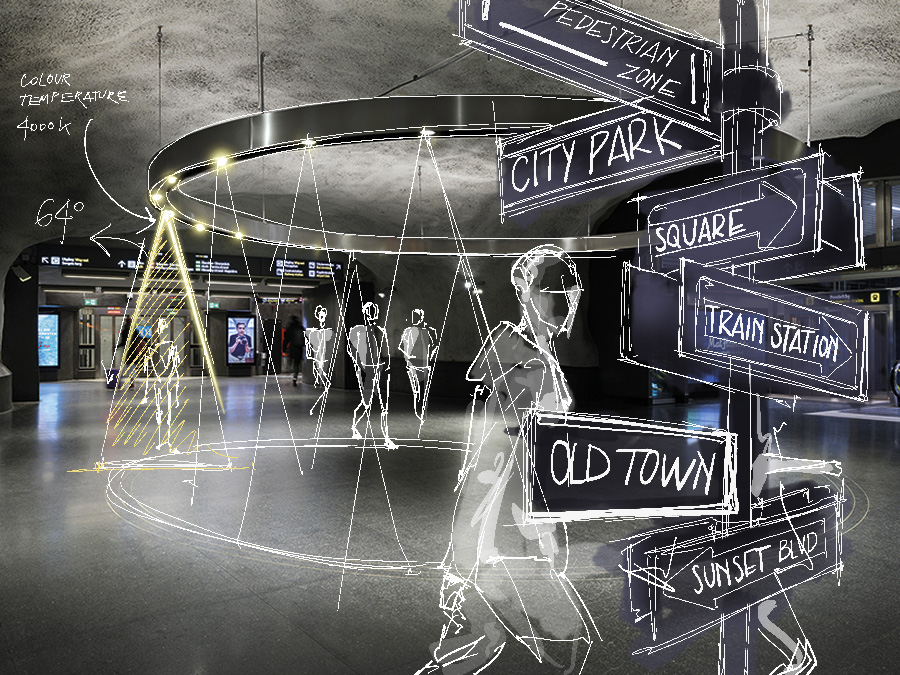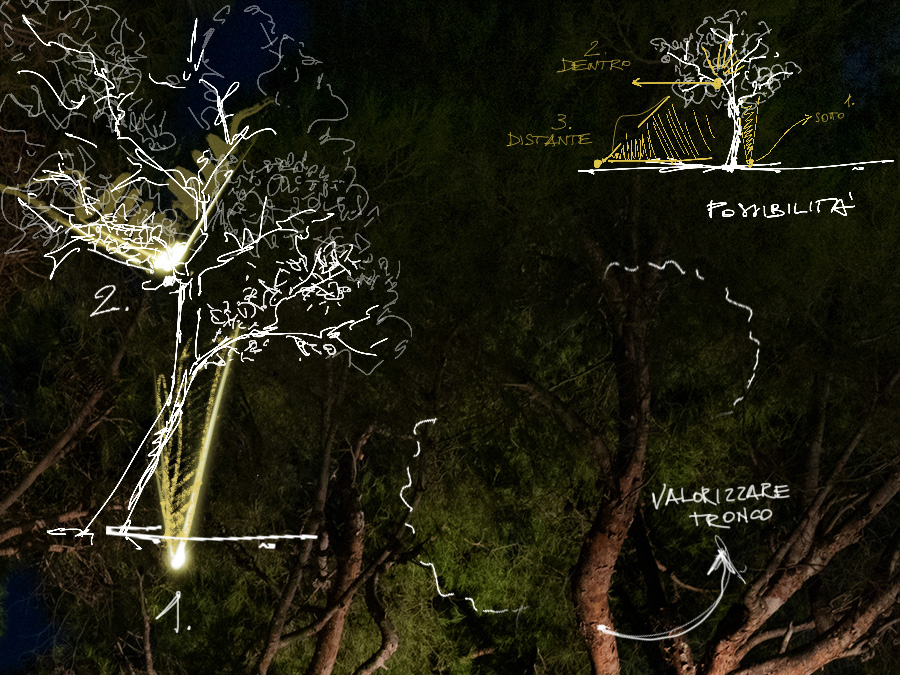In the second part of our visit to places of worship, we look at the light that vitalises the spiritual atmosphere from the inside.
Vaults above our heads and beneath our feet
Religious buildings are devoted to the contemplation and prayers of the faithful. The lighting welcomes them and contributes to introspection in a variety of ways depending on the architecture, the building’s history, and the activities that take place there.
Contrasts between light and dark create hierarchies and guide the visitor inside. As our gaze wanders down the side aisle of a church, it is drawn by the rhythmic pattern of the vaulted ceiling, and we are so immersed in the atmosphere that we hardly realise that our bodies are still standing at the entrance.
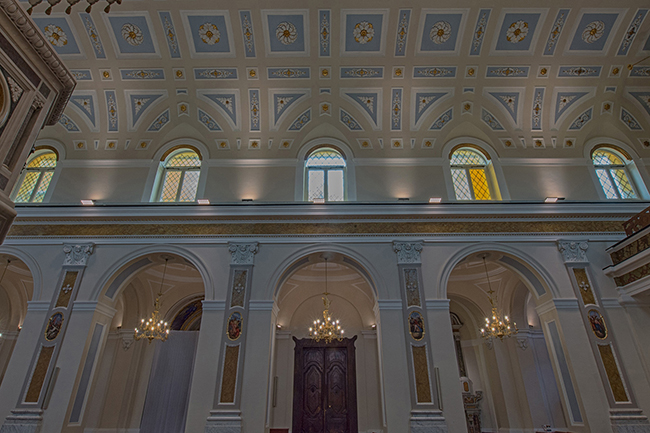
Duomo 4.0, customized version, 3000K, 58W, 40°, stainless steel Go to the project and credits
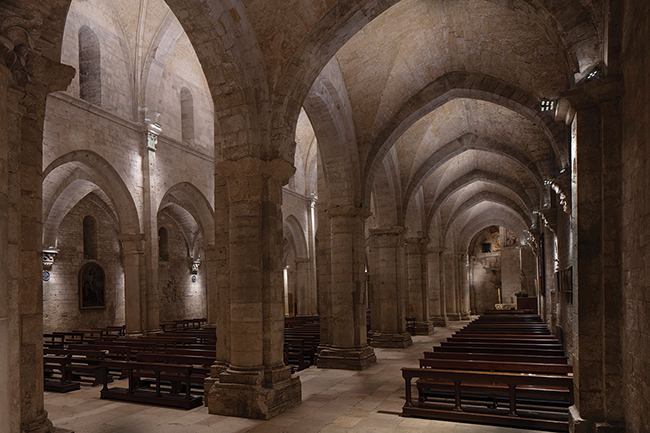
Duomo 2.0 / Duomo 3.0 / Duomo 4.0, customized version, 3000K, 14W - 28W - 29W - 39W, 40°, white Go to the project and credits
A sense of natural reverence accompanies our steps as we make our way to the nave, where the lighting focused on the vaulting gives a sense of both protection and majesty. Our gaze is drawn upwards. Whether it alights on frescoes or architectural decorations there, the lighting fixtures usually installed in this area have wide optics that light the ceiling uniformly.
Since places of religious worship have historically been closely linked to artistic patronage, the artworks on ceilings and floors are very important in these spaces.
As in a museum, choosing fixtures with light sources with a high colour rendering index (CRI>90) allows you to show the art in its true colours, whether it be paintings, frescoes or mosaics.
In modern and contemporary religious buildings, figurative or decorative artistic representations tend to give way to the intrinsic artistry of the architecture itself, and volumes and materials are accentuated with a skilful use of lighting.
In the church depicted below, the light emitted by the profiles with elliptical optics grazing the oblique walls highlights the texture and geometry of the wooden ceiling.
We are in northern Europe, and the light colour also helps create a warm atmosphere. The 2700K white light, combined with the material, gives an indirect light that warms up the room and communicates a sense of welcome.
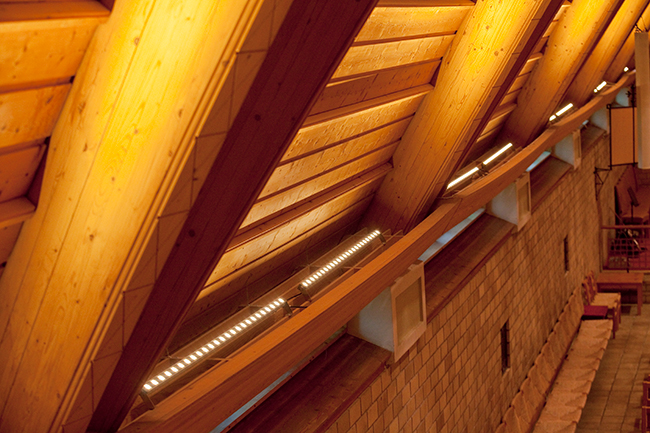
Neva 1.2, 2700K, 45W, 10°x40° Go to the project and credits
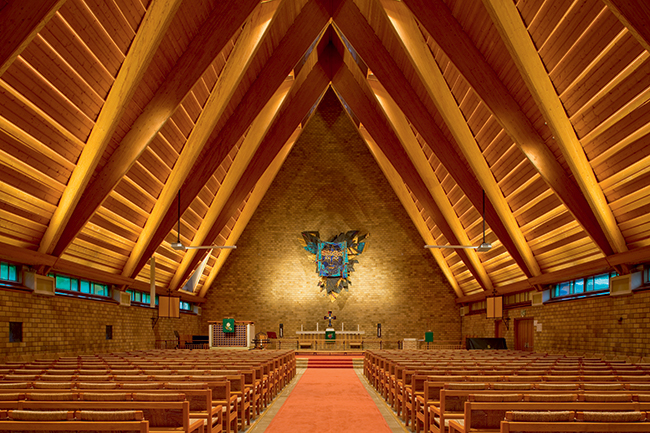
Neva 1.2, 2700K, 45W, 10°x40° Go to the project and credits
The same linear profiles are installed on the floor of this university chapel. Their narrow beam of grazing light warms the colour of the bricks at the foot of the architectural cross carved into the wall. In this case, the use of lighting fixtures along the oblique edges between the wall and ceiling is very respectful of the areas in which natural light operates – “a physical element in this architecture” (architect Ignazio Lo Manto).
The artificial lighting of the LED fixtures and the natural light combine to create an atmosphere conducive to prayer and introspection.
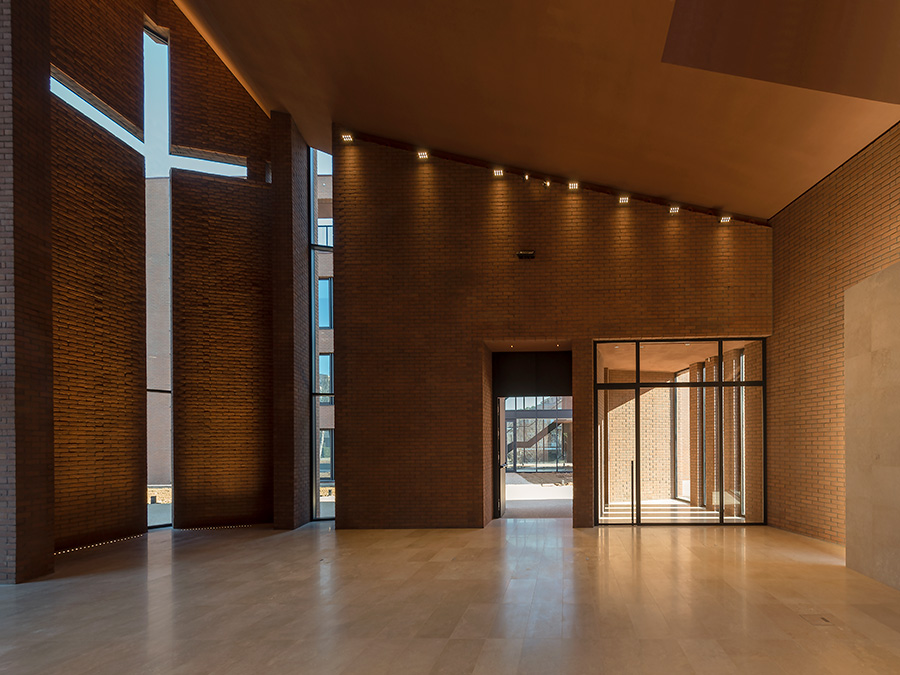
Neva 1.2, 3000K, 45W, 11° / Duomo, 3000K, 28W, 43°, anthracite / Bitpop 1.0, 3000K, 8W, 42°, white Go to the project and credits
Positioning the fixtures
We have seen a number of lighting options, most of which choose to position the fixtures high up, along the aisles and vaults.
Is this a functional choice? Or an aesthetic one? It’s both.
👉Aesthetics. Highlighting architectural environments means taking great care over what we don’t want to highlight, including the lighting fixture itself. For the reasons described in the previous article, in most cases recessed installation is not permitted inside historical structures, and surface-mounted fixtures, such as projectors, are used.
Installing the projectors on the cornices is one of the most common practices in architectural lighting precisely in order to hide the projectors from sight and leave visitors just to enjoy their light and the emotions that the vault, and its frescoes, for example, can arouse.
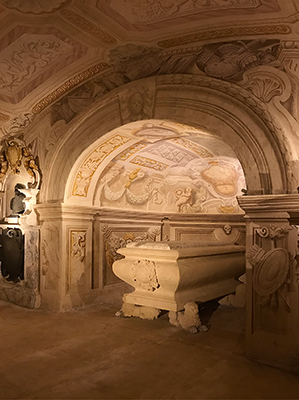
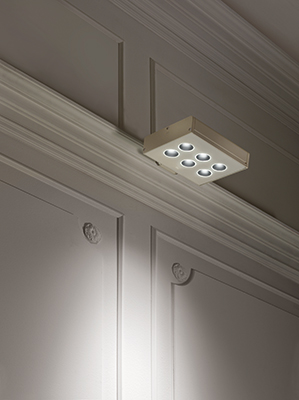
If strategic positioning is not enough, a further aid to rendering the lighting fixture more discreet is the finish, to help it blend into the architectural surroundings.
We have developed a finish specifically for these contexts: antique white, which is similar to the warm tones of the stone and plaster in these spaces. Alternatively, RAL finishes can be requested to precisely match the place where the fixtures are to be installed.
👉Functionality. In historic churches, as in other elements of our architectural heritage, invasive installation must be kept to a minimum, to avoid damaging the original structures more than necessary.
Attaching projectors by their own bases or by special brackets fixed to the wall near the cornice makes it possible to reduce the number of holes to a minimum and to run the cables along these architectural elements.
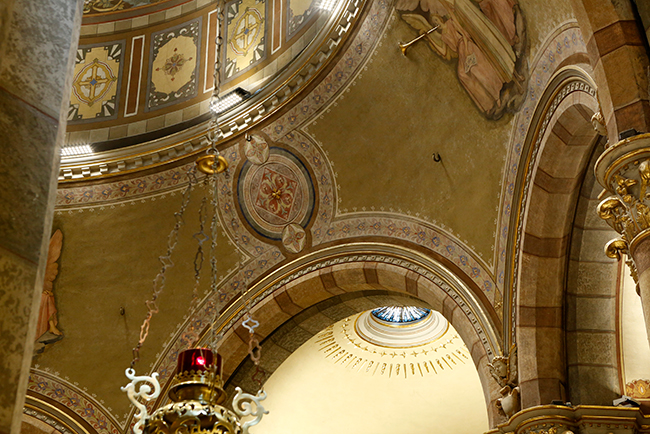
Projector for indoor applications, 3000K, 58W, 40°, white. Santuario di Nostra Signora di Moretta, Alba, Cuneo, Italy
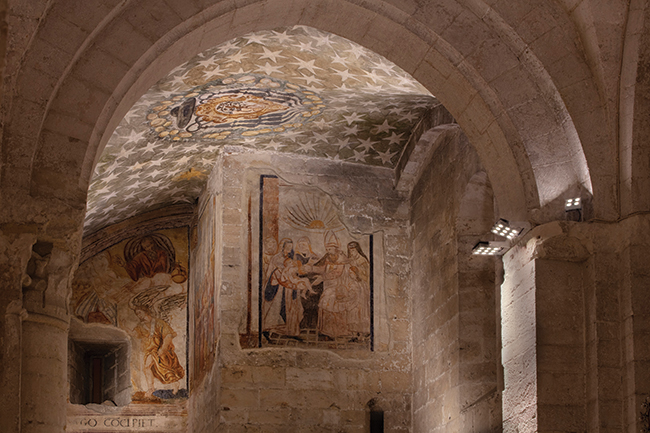
Duomo 3.0, customized version, 3000K, 20W, 40°, white Go to the project and credits
The tiltable head of this type of lamp allows the light emission to be directed so it reaches the object to be illuminated.
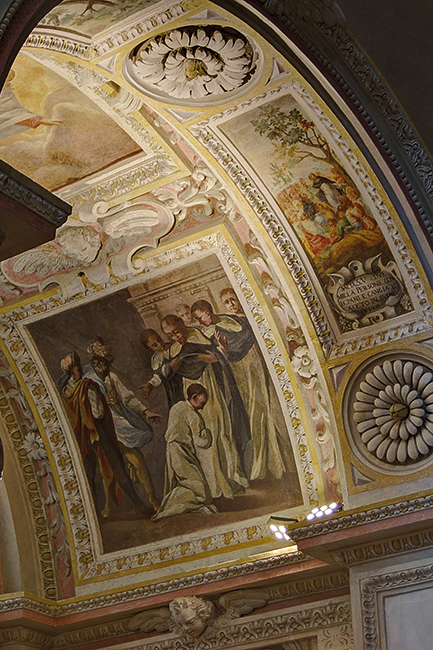
Duomo 3.0, customized version, 3000K, 29W, 40°, stainless steel Go to the project and credits
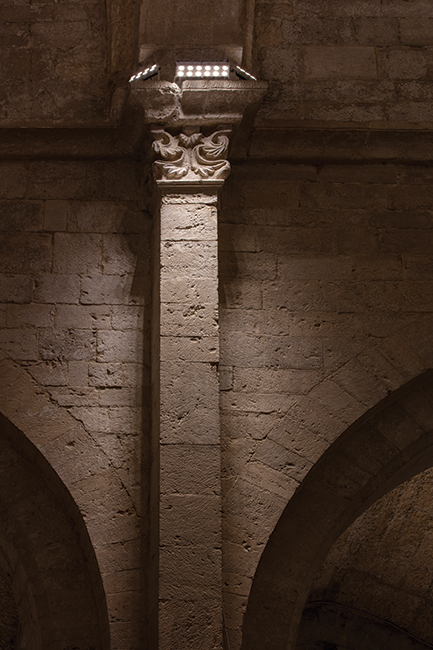
Duomo 3.0 / 4.0, customized version, 3000K, 28W - 39W, 40°, white Go to the project and credits
Additionally, special adjustable, jointed brackets allow the projectors to jut out and be directed even more precisely, to illuminate a capital or even the underside of a cornice.
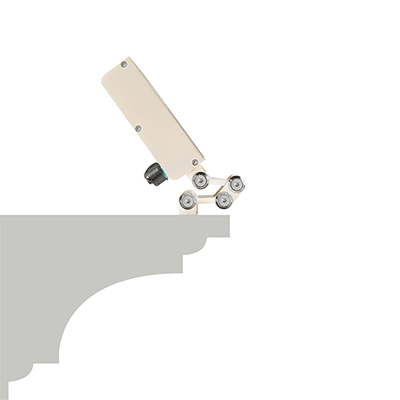
Let us now consider cases where the projector is to be installed on an impost capital with very little room for manoeuvre. We start adjusting the lighting fixture’s bracket and head, but nothing doing: we are short by just a few centimetres from being able to adjust the fixture so that it lights the vaulted ceiling!
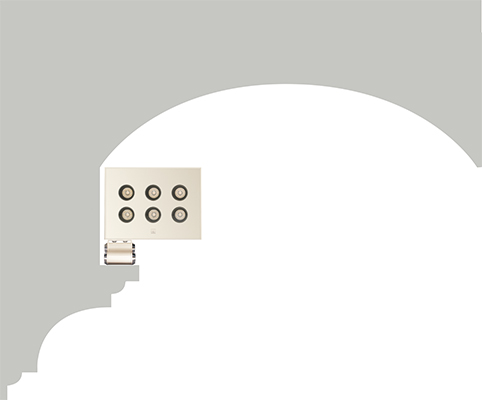
For situations like this, you really need a lamp that’s “off its head” – one that can slide along the bracket so that the light source can jut out and gain those precious centimetres.
💡 📞 💡
Are you looking for a one-of-a-kind bracket?
Tell us what you need, and we can design the right bracket together.
Lighting the nave
As we said in the previous article, as Italians, our experience mainly involves Catholic religious buildings, so we’ll be looking at some churches where the decision was made to pay particular attention to the area used by the congregation.
The nave is normally lit with uniform lighting, achieved using projectors with optics most often between 30° and 40°. A wide beam also ensures adequate light projection, given that the fixtures are installed at an average height of seven metres. This type of lighting allows worshippers to find their bearings and comfortably take their seats before the service begins.
The fixtures can be positioned on the side cornices, as in the Basilica Santa Maria della Neve in Naples (first photo), or they can be placed in the centre of the nave, as in the Church of the Eremitani in Padua (second photo). Here, with the aid of special remote controls, the projectors are adjusted according to requirements, so that light is cast on the nave only when it is needed. In the modern church of Santissimo Crocifisso (church of the Holy Crucifix) in Foggia, on the other hand, the lower ceilings house track systems with projectors directed onto the pews (third photo).
In fact, in the latter church, which was constructed relatively recently (1995) and underwent an even more recent renovation, there were no structural constraints to the lighting design. Double-beam wall-mounted fixtures were installed on the colonnade that embraces the nave, maximising the indirect lighting made possible by the ceiling’s modest height. Behind the wall-mounted fixtures, diffuse-light downlights mark the Stations of the Cross.
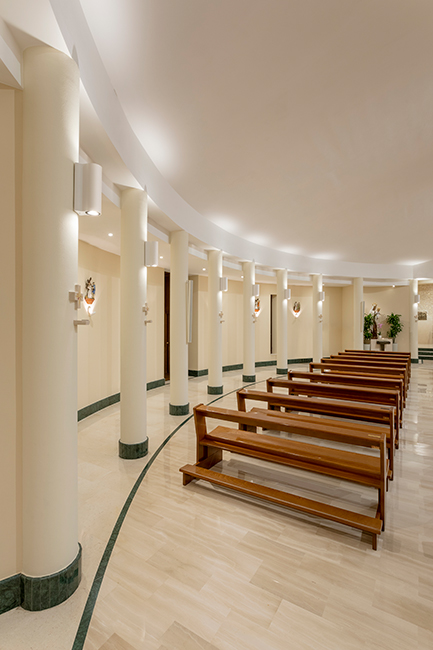
Intono 4.2, 2700K, 38W, wall grazing + asymmetrical, white, customized version DALI / Turis 1.1, 2700K, 11W, white, DALI Go to the project and credits
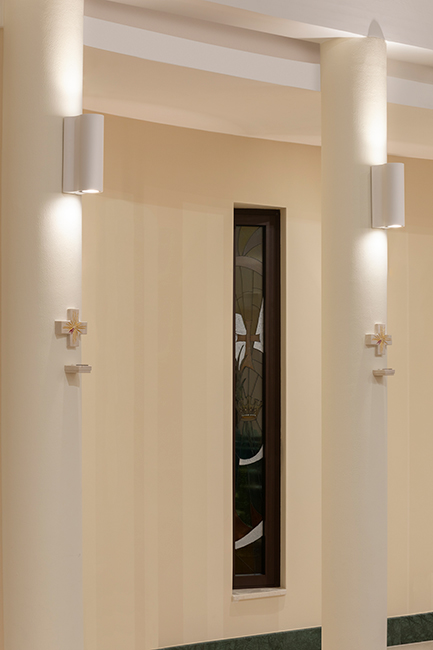
Intono 4.2, 2700K, 38W, wall grazing + asymmetrical, white, customized version DALI Go to the project and credits
Below is an example of how this religious pilgrimage may be lit.
Each station is enclosed in a halo of light drawn by 42° optics, making it emerge from the shadowy wall it stands on. This effect is achieved with a 30-centimetre arm, on which the lighting fixture is mounted, and a double joint, which together allow the light output to be precisely adjusted. Looking at these bas-reliefs, we are struck by the bright colours in which they are painted: the projectors’ LED sources have a colour rendering index >90, which reveals these colours faithfully.
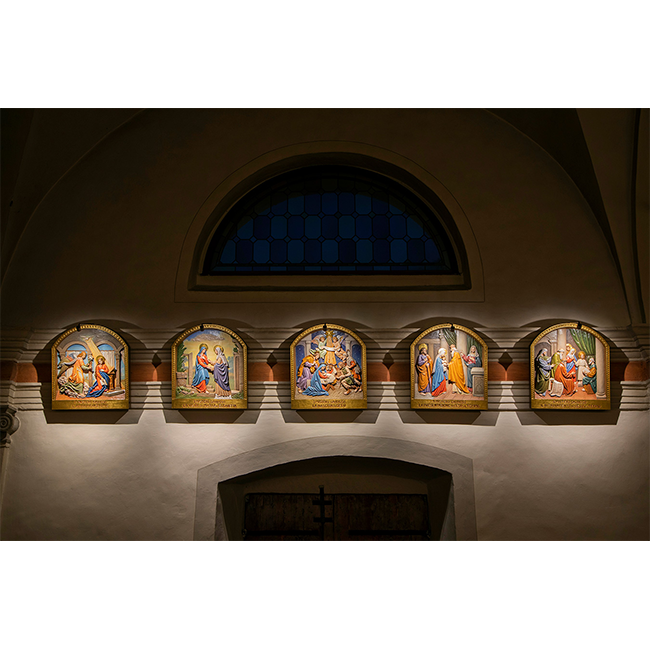
Krill 3.0, 3000K, 4,5W, 42°, antique bronze, rigid arm 300 mm Go to the project and credits
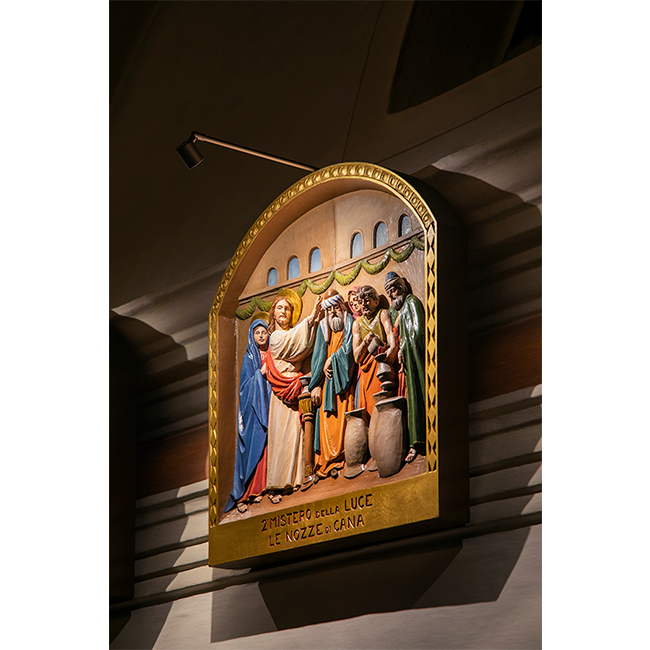
Krill 3.0, 3000K, 4,5W, 42°, antique bronze, rigid arm 300 mm Go to the project and credits
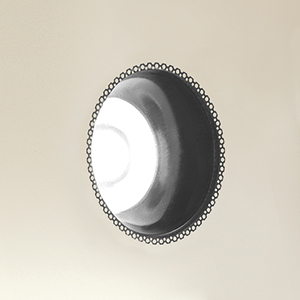
God save the eye ;)
Downward-pointing lighting fixtures could disturb the eyes of tourists admiring the nave’s architecture or of worshippers looking up from the nave. The choice of lamps with deep-set optics, in other words, with the LED light source on a plane that’s set back from the fixture’s screen and therefore less obvious, safeguards the eyes and the experience of tourists and faithful alike. Anti-glare accessories such as honeycomb louvres and snoots further conceal the light source.
The precision touch of accent lighting
Lighting something from a distance with 6° narrow optics always makes quite an impression. The observer wonders where the light that can hit its target of an architectural detail or a statue with such good aim is coming from.
we see in the church of Saint Sulpice in Paris, below, projectors with these optics, installed on the cornice above the high altar, exactly reach the statues of Christ, the Virgin and eight apostles.**
** If you’re wondering, “But weren’t there 12 apostles?” you’re right, there are four missing. Apparently, the sculptor Edmé Bouchardon passed away before completing the work.
In this case, the contrast between light and shadow adds dramatic solemnity to the scene on the altar, the focus of attention during the service.
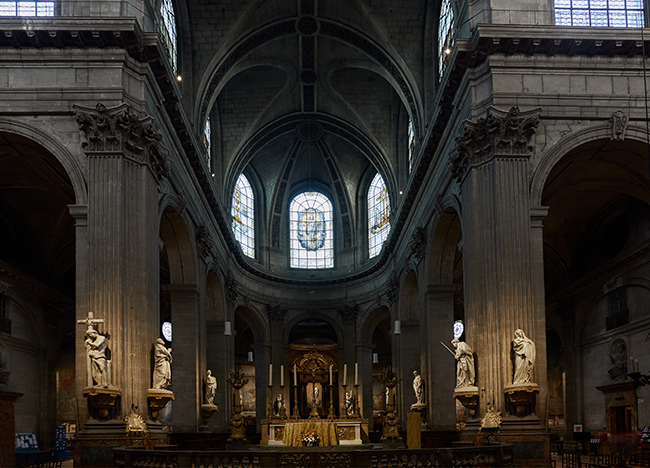
Siri 2.0, 3000K, 16W, 6°, anthracite Go to the project and credits
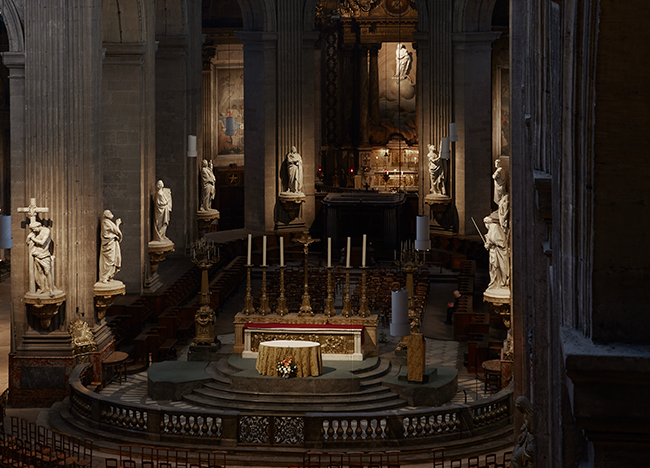
Siri 2.0, 3000K, 16W, 6°, anthracite Go to the project and credits
In another solution for the high altar (photo below), we see the effect of several projectors, nestled in the cornice ledge, each with different optics and different targets.
📌📌 Two projectors with 40° optics are aligned with the impost capitals that frame the upper part of the vault of the apse and highlight the wall’s architectural design with grazing light.
📌 A projector with 8° optics illuminates the lectern.
📌📌 Two projectors, one on either side of the apse, cast a beam generated with 17° optics towards the crucifix, creating symbolic shadow profiles.
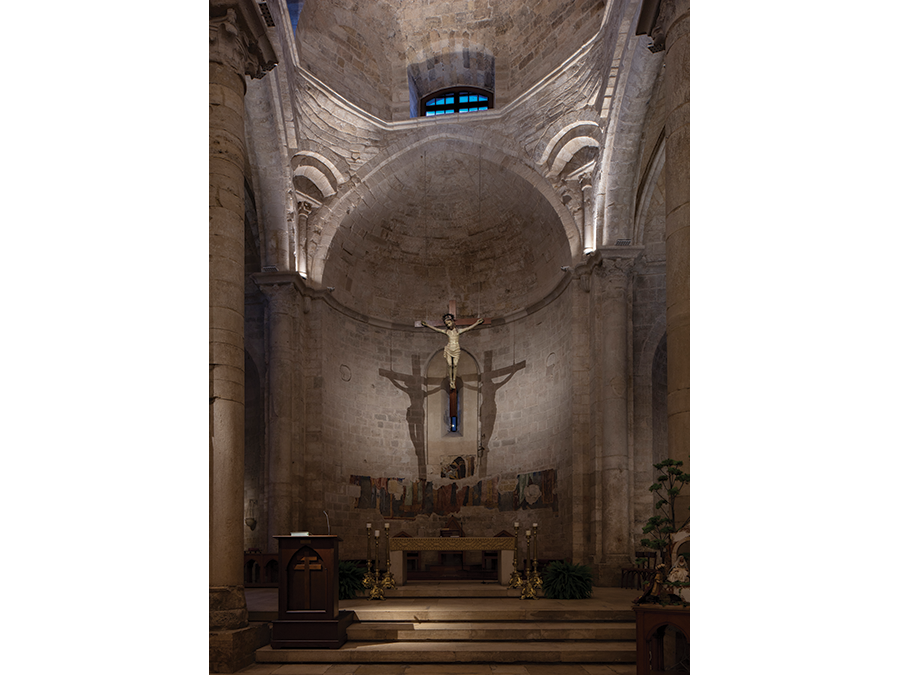
Duomo 3.0, customized version, 3000K, 29W, 40°, white / Ginko 2.0, 3000K, 7W, 8°, white / Ginko 2.0, 3000K, 7W, 17°, white Go to the project and credits
We move to Malta and peek through narrow slits into a chapel with contemporary lines. An accent light from a projector falls on the figure of Christ and, in concert with the violet-coloured background, creates an ethereal and mystical atmosphere.
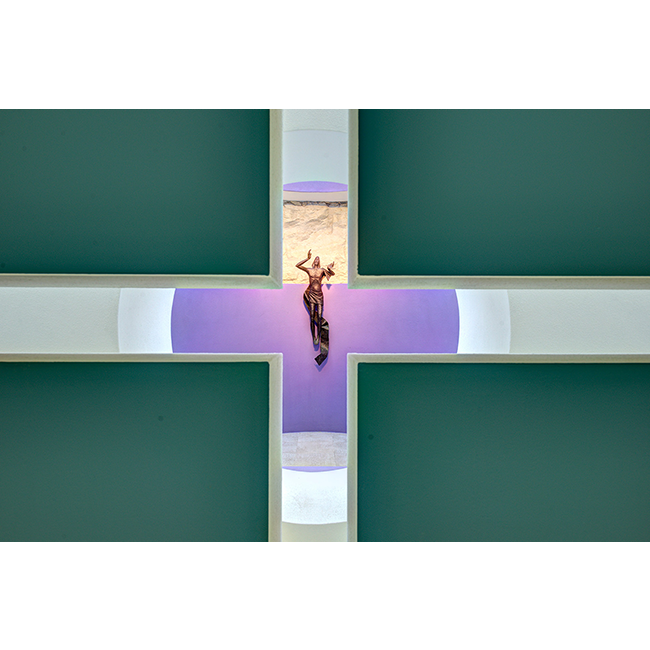
Spot, 3000K, 8W, 20° Go to the project and credits
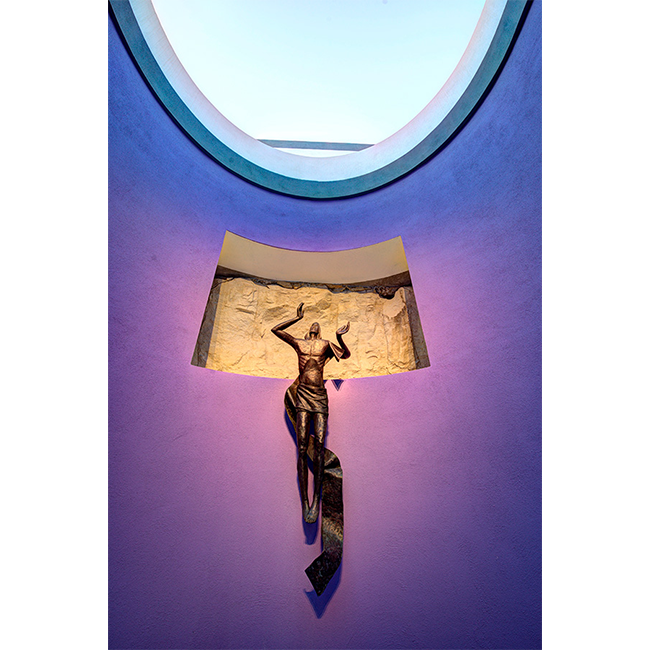
Spot, 3000K, 8W, 20° Go to the project and credits
Sideshows
Among the elements to be considered in the lighting design of a church with a traditional structure are the votive altars.
In the chapels along the side aisles or at the ends of the transept, votive altars require lighting that makes their presence visible without drawing too much attention to them, which is usually reserved for the high altar. Again, if altarpieces or colour details need to be enhanced, lighting fixtures with a high colour rendering index are recommended.
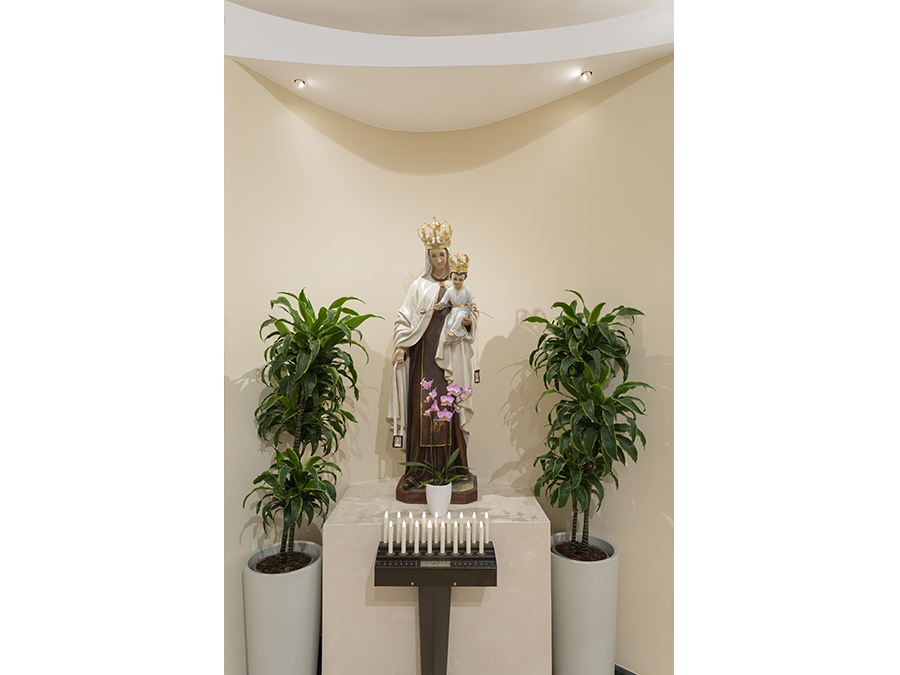
Ciak 2.7, 2700K, 5W, 32°, white Go to the project and credits
Same place, different atmosphere
Different moments and functions require different lights: lighting during a service should differ from everyday use. In the former case, worshippers are in close contact with the celebrant, whereas, in the latter, each person engages in individual moments of prayer.
To accommodate this, different dedicated lighting scenes can be set up to be activated according to need or at programmed times. We know how closely the atmosphere of a room is linked to the light intensity. Dimmable lighting fixtures allow you to adjust the intensity of the light output to create exactly the situation desired.
💡 📞 💡
You may find yourself needing to revamp the lighting in a location and having to adapt to the existing electrical installation, while also ensuring ease and comfort of use. If a lighting fixture that meets the project’s requirements in terms of technical and aesthetic characteristics is not equipped with PUSH control, you can always request its customization.
In addition to the light intensity, the atmosphere is also created by the light colour chosen for the setting and for the elements we wish to enhance. In places of worship, light sources with a colour temperature of 3000K or warmer shades are usually chosen: they are reminiscent of old-fashioned oil lamps and candles and promote a sense of welcome and intimacy. If you want to go further than 2700K white, we can make 2200K or amber fixtures on request.
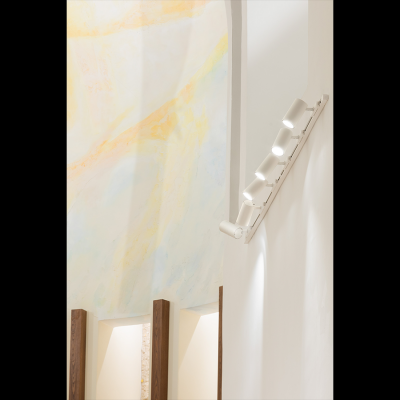
Stinger 2.0, 3000K, 20W, 60°, white Go to the project and credits 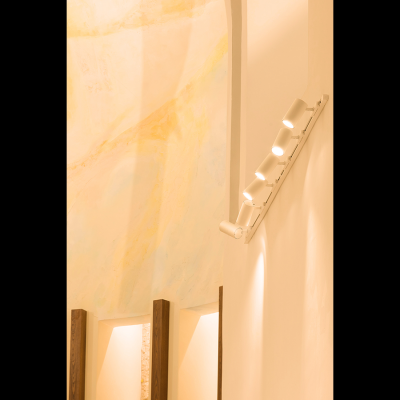
Illustrative image of 2200K white light 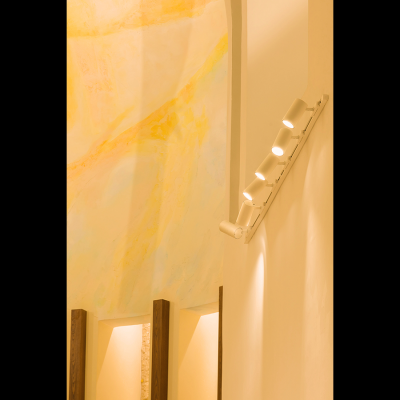
Illustrative image of amber-coloured light
Sometimes the choice of light colour can explore less-usual avenues. That’s the case in this German church, where the high altar area can be coloured using RGBW recessed fixtures when required. The altar area, bathed in purple, stands out from the nave, which is lit in 3000K white, making us recognise that something special and mystical is happening there.
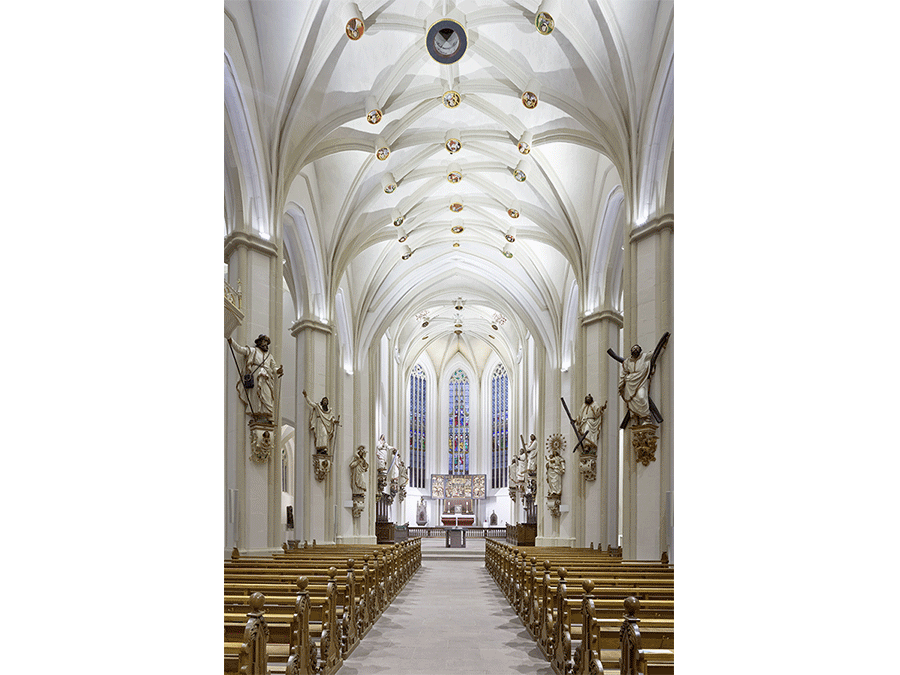
Duomo 2.0 / 3.0, customized version, 3000K, 14W - 28W , 30°, white / Bright 5.H, RGBW, 20W, 20° Go to the project and credits
We have lingered on the parvis and the esplanade of places of worship, wandered down the aisles inside the churches, looked up at the frescoes and ceiling vaults and lowered our gaze to the high altar.
Now we want to hear about your experiences and your project, so please
Bibliography
Saint Sulpice, Paris: https://www.paris.fr/pages/l-eglise-saint-sulpice-retrouve-les-statues-restaurees-d-edme-bouchardon-4805/, 03/02/2021

